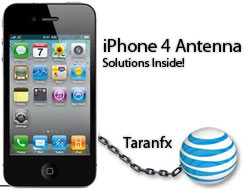 Everyone seems to be complaining about the iPhone 4 signal Reception issues, when held Incorrectly. Holding iPhone 4 in left hand covering left side’s bottom bridges the left and bottom antennas which results in a serious attenuation in signal.
Everyone seems to be complaining about the iPhone 4 signal Reception issues, when held Incorrectly. Holding iPhone 4 in left hand covering left side’s bottom bridges the left and bottom antennas which results in a serious attenuation in signal.
Obviously, the issue is not same for every one. Users living in areas having good signal coverage would not observe issues. Every phone, agnostic of brand/make, has antenna attenuation problems when covered with hand. These attenuations can lie anywhere between 14dB and 18dB drops. But iPhone 4’s attenuation is as high as 24db, which means total loss of signal in areas where you otherwise get upto 4 bars.
Related: iPhone 4 vs. Android – Why Apple has lost it
That’s definitely a significant problem. But its not as bad as what it might look like.
Steve jobs already hinted on fixes, but is it practically possible to fix an Hardware issue via a software/firmware updates?
iPhone 4 can actually use signal at the lower threshold far more reliably than any previous iPhone could. Thanks to the new baseband, hardware is much more sensitive, which makes the reception is massively better on the iPhone 4 in the real world.
Apple appears to be using digitally adjustable solid state capacitors that can tune the iPhone 4’s antennas to a different level where problems are resolved. Hiring new antenna engineers to reliably test this makes much more sense than ever.
Fixing iPhone 4 Reception via Baseband Tuning
The hack lies in the common RF fundamental: Antenna impedance matching. In every wireless application,every circuit and antenna need some kind of impedance-matching circuit between them. Impedance matching is essential for maximum power output for a given input or in more technical terms: minimum Voltage standing-wave ratio (VSWR) loss, and improved efficiency.
Modern RF devices (iPhone 4 might be the first one) can use variable capacitance to tune more flexibly on runtime. For example, when you place your cell phone to your ear, your body detunes the antenna, the surrounding the ambiance also adds to it. The problem is particularly acute in 3G phones that are technically multiband, multimode handsets that must operate over a wide range of frequencies.
The VSWR in a typical handset is rarely better than 5:1 (3.5 dB loss) when filters, switches, or duplexers are added in. When users put their hands on the handset antenna, they can raise the VSWR to 9:1, severely reducing transmitted/received power and hence the efficiency.
This Impedance-match problem has been solved over the years in higher-power transmitters and larger equipment with variable capacitors or inductors in a feedback network that automatically compensates for changes in antenna orientation, impedance variations, or frequency changes by user’s hands. Very recently, they have been made portable enough to bring to cell phones like iPhone 4.
Solution: All we need is a capacitor that’s small and is controlled by internal circuitry. Dune, pioneers in this technology, has used MOSFET switched capacitors that permit higher-frequency operation, faster switching, and higher Q (quality, tuning). The digitally tunable capacitor (DTC) chip contains five capacitors switched by MOSFETs that operate from a serial input bus with a 5-bit code providing 32 possible capacitor values which help cellphone adjust to surroundings dynamically, without a glitch.
Typical switching speed is less than 5 µs, for the frequency range up to 3 GHz, and power handling up to 40 dBm, which is good enough for phones which operate at 800, 1800, 1900 mhz.
Tuning Mechanism: The closed loop system uses a directional coupler to sense forward and reflective power. A tuning algorithm is implemented to provide automatic adjustment to bring the VSWR to its lowest possible value.
Verdict:
The fix might be coming anytime, it may or may not fix 100% of the issue, but the degree of improvements rather depends upon how smartly Apple’s Engineers tune this antenna.
Tech details: electronicDesign
We write about Latest in tech, Apple, iPhone, Tablets, Gadgets, Open Source, Programming. Grab them@taranfx on Twitter or below:
loading...
loading...
